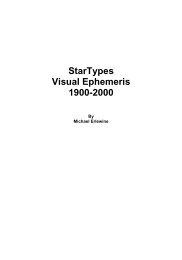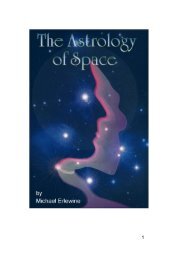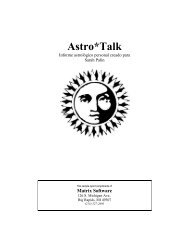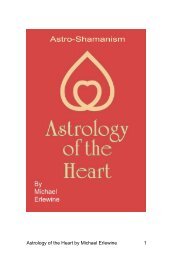The Art of Focus Stacking - Matrix Software
The Art of Focus Stacking - Matrix Software
The Art of Focus Stacking - Matrix Software
You also want an ePaper? Increase the reach of your titles
YUMPU automatically turns print PDFs into web optimized ePapers that Google loves.
In a Few Words.... the Key.<br />
My Key to Taking Good Photos<br />
<strong>The</strong> poet Gerard Manley Hopkins came up with a concept<br />
that struck me as true. He even made up his own<br />
word to describe it, “inscape.” Inscape was to Hopkins<br />
an insight or path into the eternal or beautiful, literally<br />
the way or sign <strong>of</strong> the beautiful in the world around us.<br />
Let me explain.<br />
I look forward to my trips out into the fields and woods.<br />
<strong>The</strong>y <strong>of</strong>fer me a chance to get my head together, to<br />
relax from the day-to-day grind <strong>of</strong> running a business,<br />
and generally to relax a bit. This is not to say that just<br />
going outside and walking in nature means that I am<br />
instantly relaxed. That usually takes time.<br />
It is the same with taking photos. In the first ten minutes<br />
<strong>of</strong> a photo shoot I <strong>of</strong>ten don’t see all that much to<br />
photograph. This too takes time, time for me to slow<br />
down, open up, and ‘see’, and let the natural beauty<br />
all around me in. It could be that I am still filled with<br />
all the workaday-world thoughts, the things I have to<br />
do, problems, and what-have-you. It takes time for my<br />
mind to relax and let go <strong>of</strong> its constant chatter. This<br />
day-to-day endless worry and thinking affects my photography.<br />
And here is where the word ‘inscape’ comes<br />
in.<br />
As I get out there and wander through the fields or<br />
wherever, I gradually start to slow down and begin to<br />
see things that are beautiful, scenes that I might actually<br />
want to photograph. Slowly my view <strong>of</strong> the natural<br />
world around me starts to open up again, and I begin<br />
to experience things differently. I begin to ‘see’. It<br />
takes time and usually does not happen all at once.<br />
This little pattern <strong>of</strong> leaves over here or the way the<br />
light comes through the forest canopy grabs me just a<br />
little bit and the chatter <strong>of</strong> my mind pauses and begins<br />
to slow down. As I walk along, some little thing<br />
or scene appears beautiful to me; I am touched by it,<br />
however lightly at first. I gradually get distracted from<br />
my daily distractions and begin to center.<br />
<strong>The</strong>se little moments are ‘inscapes’, ways out <strong>of</strong> my<br />
mundane world and into the beauty <strong>of</strong> nature or, more<br />
accurately, back into the state <strong>of</strong> my own mind or being.<br />
As I take my time, I am able to see the beauty in<br />
things once again, and what I am seeing suddenly<br />
seems worth photographing. Like most <strong>of</strong> us, I photograph<br />
what catches my interest, what I find beautiful<br />
or worthy in the world around me.<br />
<strong>The</strong>se inscapes are signals that catch my attention,<br />
and they flag me down on my busy way forward to<br />
nowhere-in-particular. <strong>The</strong>se moments and signs<br />
are how I stop going nowhere and manage to almost<br />
miraculously arrive somewhere once again, perhaps<br />
only at my own peace <strong>of</strong> mind. This is one <strong>of</strong> the functions<br />
<strong>of</strong> the beautiful, to catch us in the turmoil <strong>of</strong> life,<br />
flag us down, and induce us to pull over and take a<br />
moment <strong>of</strong> rest - some time out. <strong>The</strong>se moments <strong>of</strong><br />
inscape are different on different days and different<br />
for different people. <strong>The</strong>y represent the clues or signs<br />
that catch our attention and show us the way into the<br />
beauty <strong>of</strong> the natural world, actually the beauty <strong>of</strong><br />
our own mind. Another way <strong>of</strong> saying this might be:<br />
what is beauty actually? What happens when we see<br />
something beautiful?<br />
Beauty is not simply somewhere out there in nature<br />
waiting to be found, but always here within us, locked<br />
within us, we who are seeing this nature. Only we can<br />
see the beautiful. Beauty breaks down the rush <strong>of</strong> the<br />
everyday world and opens our heart a wee bit, making<br />
us vulnerable once again, more open to experience<br />
and input.<br />
Through the natural beauty outside we go inside and<br />
experience the inner beauty <strong>of</strong> things, which is none<br />
other than our own inner beauty. That is what beauty<br />
is for, to be touched on, seen, so that we find once<br />
again the beauty within our own hearts that we may<br />
have lost through the distractions <strong>of</strong> our daily life. We<br />
forgot. We look outside in nature to see in here, to see<br />
into our own heart once again.<br />
We can be sensitive to beauty in our photography. I<br />
would hate to tell you how many photographs I have<br />
<strong>of</strong> this or that butterfly or critter that are perfectly good<br />
photographs, but are empty <strong>of</strong> magic or meaning.<br />
<strong>The</strong>y are well lit, well composed, and have everything<br />
that makes a good photograph except that ‘magic’<br />
that keys or excites me. Instead, they are ‘pictures’ <strong>of</strong><br />
a butterfly, but they have not captured any essence<br />
<strong>of</strong> anything. <strong>The</strong>y might as well be in a field guide –<br />
snapshots in time with no meaning.<br />
<strong>The</strong> reason for this (so I tell myself) is because they<br />
just happened to be there, photographic opportunities.<br />
I saw them and I took a photograph, but at the time<br />
they did not instill or strike any particular beauty in me.<br />
This, to me, is “gotcha” photography, taking a photo<br />
because I can, not because I saw beauty in it or was<br />
moved to do so. <strong>The</strong>re was no inscape moment, no<br />
moment <strong>of</strong> vision – snapshots only.<br />
I find that it really worth paying attention to what<br />
strikes me as beautiful or meaningful and photograph<br />
that, rather than just photographing the Grand Canyon<br />
because it is there or I am there. A lasting photograph,<br />
in my opinion, requires more <strong>of</strong> me than that, by definition.<br />
It has to mean something to me and for that<br />
to happen I need to actually be moved or inspired.<br />
Photographs that have special meaning for me usually<br />
have some form <strong>of</strong> inscape into a special moment that<br />
inspires me to capture the scene in a photo.<br />
We can wander for miles looking for something to<br />
photograph, chasing down this or that butterfly or animal…<br />
searching. Or, we can slow down and let nature<br />
herself show us the signs, the inscapes through which<br />
120

















